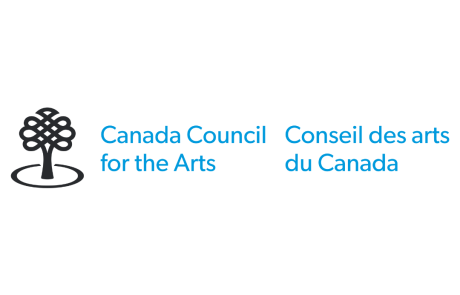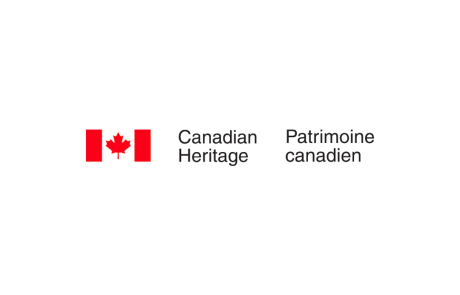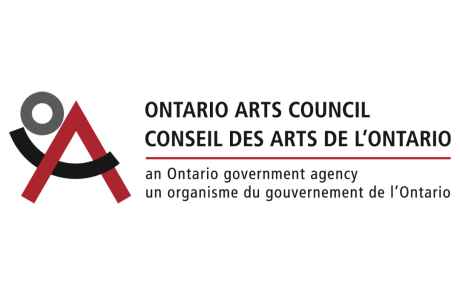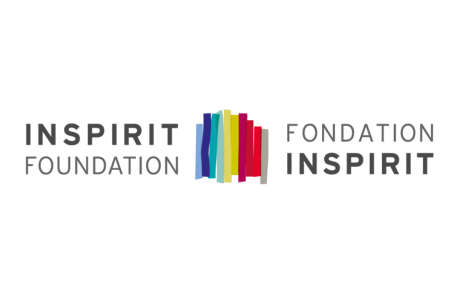Stayin’ Alive
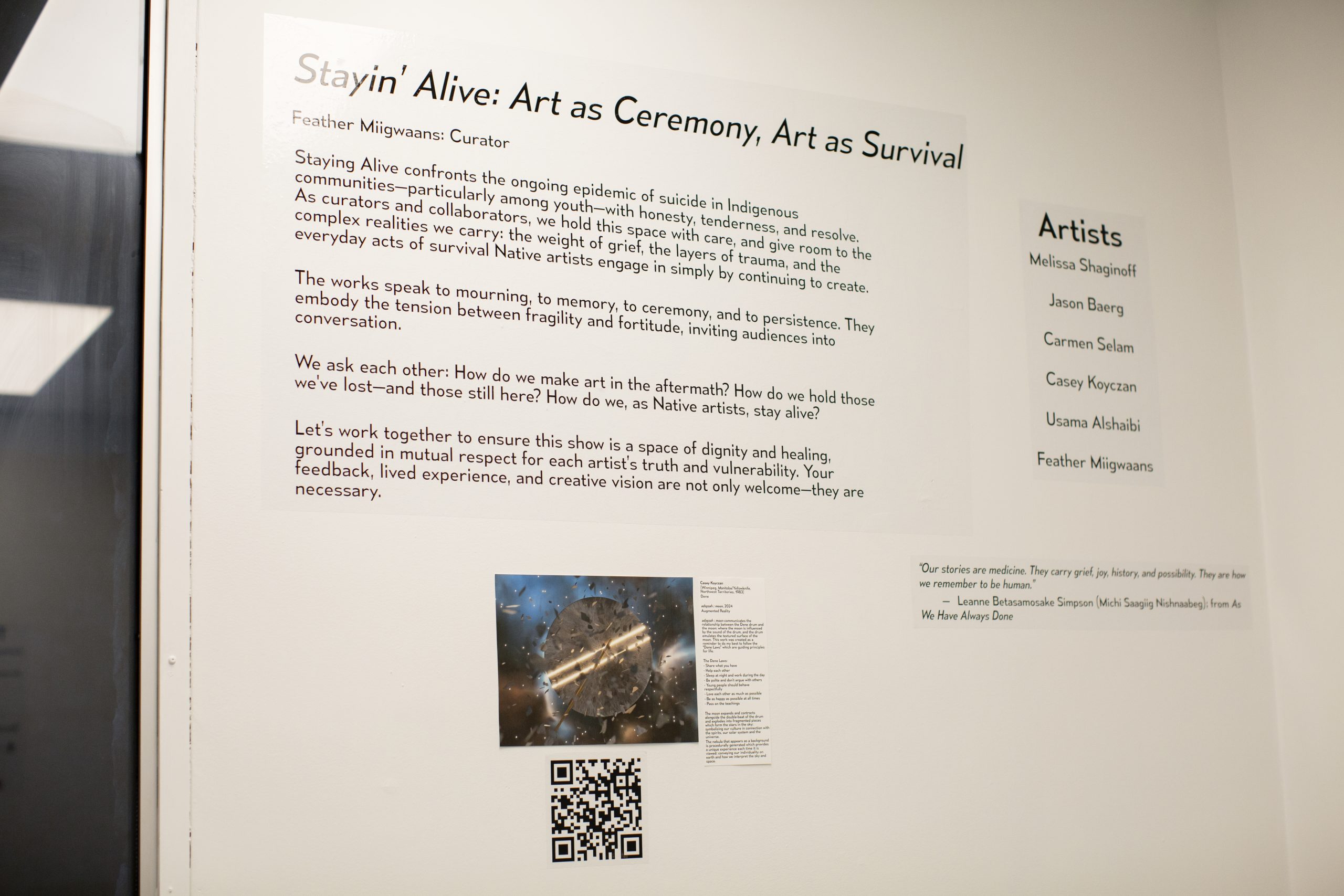
Echo Lines Installations Ottawa 2025, Photography Credit: Tracey Lynne Photography
Echo Lines: Curatorial Mentorship Program
Stayin’ Alive: Art as Ceremony, Art as Survival
Curatorial Essay by Feather Miigwans
In a world shaped by colonial rupture and ongoing structural violence, Indigenous artists have long understood that art is not a luxury or a product—it is a method of survival. Art is medicine, memory, resistance, and reworlding. In Stayin’ Alive: Art as Ceremony, Art as Survival, I brought together four artists working in expanded media, including film, performance, and augmented reality, to explore how we keep living through ongoing collapse biologically, but also spiritually, politically, culturally. I also wanted to explore how we tend to each other through image, through song, through digital kinship.
At the heart of this exhibition is the concept of survivance. This historic term was adapted by Anishinaabe scholar Gerald Vizenor to mean “an active sense of presence, the continuance of Native stories, not a mere reaction, or a survivable name.” This sense of creative endurance, of going beyond survival into assertion, is at the heart of this exhibition.
The works in this exhibition speak to each other through their shared engagement with grief and transformation. Each artist, in their own way, confronts the weight of personal, collective, and ancestral loss and finds within it the drumbeat of persistence. Whether through heartbeat, moonlight, or the fragmented textures of memory, these pieces reveal that art can be a process of metabolizing trauma into motion.
While augmented through participation in ARCA’s biennial gathering Against the Current, this exhibition emerged from the older and deeper act of coming together across nations to share stories, teachings, and technologies—the spirit of Gathering itself.
“The truth about stories is that that’s all we are,” Thomas King (Cherokee)
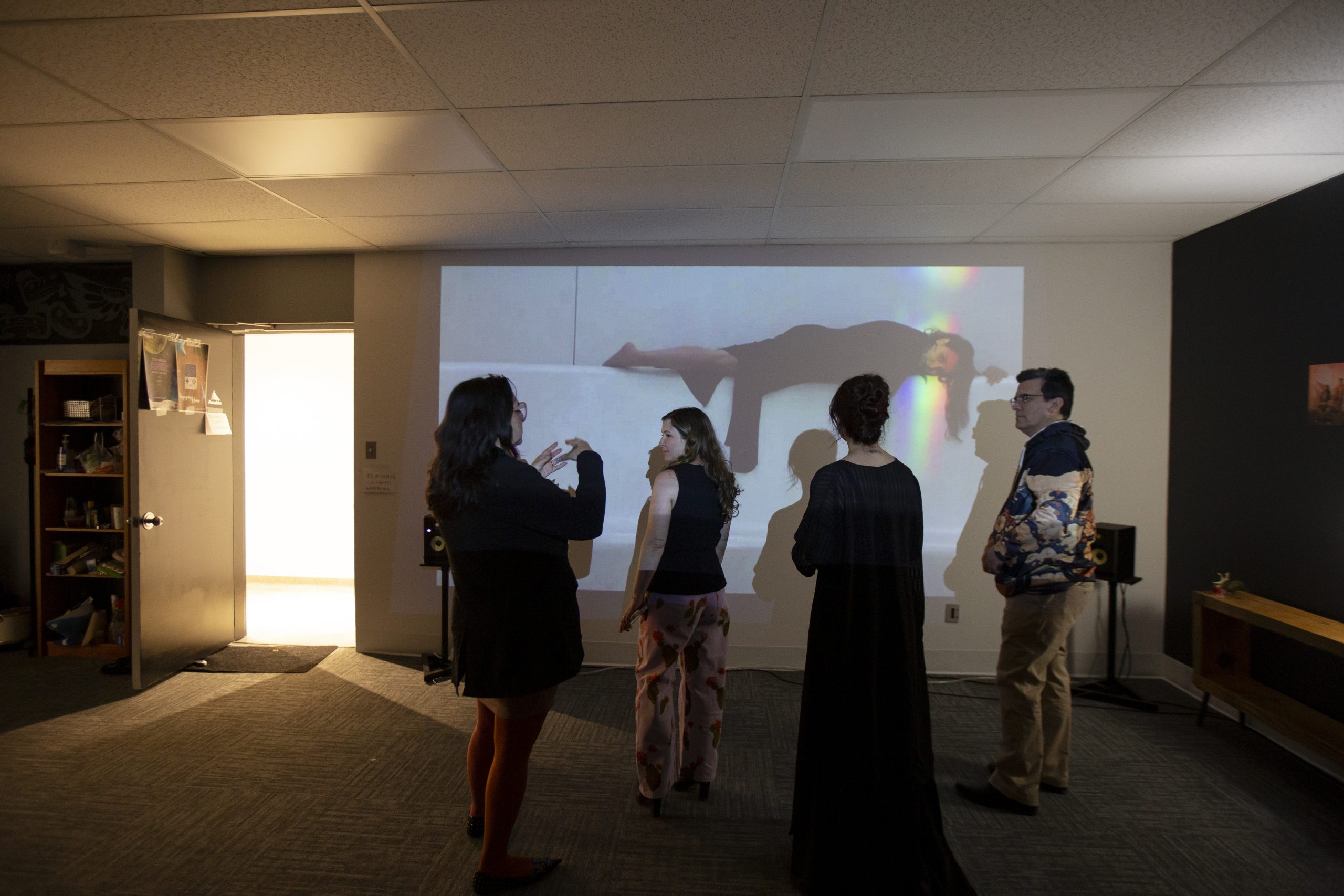
Echo Lines Installations Ottawa 2025, Photography Credit: Tracey Lynne Photography
In Stayin’ Alive, the stories live as moving image, spectral interfaces, and intergenerational memory held in code. Each work in this show reaches beyond the screen or the lens to make contact with something more alive.
Carmen Selam (Yakama/Comanche) brings her visual and sonic language to film with work that centers queer Indigenous womanhood and ancestral presence. Her short film, Switch Dance, is a kind of medicine song that is attuned to both grief and beauty, survival and ceremony. Selam reminds us that memory is not static but embodied and activated through relation.
As legal scholar Val Napoleon (Saulteau/Gitanyow) writes, “Law lives in the stories, songs, and the practices of the people.” Selam’s work reminds us that artistic practice is also a form of embodied law—carrying protocols, witnessing, and continuance. In the shared rhythm of the exhibition, her piece feels like a first drumbeat, calling others into the circle.
Usama Alshabi (Iraqi/Palestinian/American) contributes Soon, a haunting and poetic short film that reflects on land, surveillance, and diasporic resistance in solidarity with Indigenous peoples. His use of glitch and blurred abstraction mirrors the fragmented, layered nature of memory and trauma.His aesthetic language resonates with Selam’s shifting, relational images. Though not Indigenous to Turtle Island, Alshabi’s inclusion in Stayin’ Alive was intentional—to extend the circle of survivance outward and make space transnational kinships in shared struggle. His work also acknowledges the reverberation of displacement that echoes across borders, adding another beat to the rhythm of the show.
Casey Koyczan (Tłı̨chǫ Dene) offers, adzęzah, an augmented reality work in which a moon shaped drum shatters when struck, scattering pieces into the cosmos. It is an image of rupture, yet also of transformation, reminding us that what breaks can also become part of a larger constellation. This gesture mirrors the glitch and blur in Alshabi’s work, the layering of fragments in Selam’s, and the heartbeat of my own. Koyczan’s digital landscapes pulse with northern futurism and Dene cosmology, rooted in land-based knowledge and technological fluency. As Angela Haas (Cherokee) notes, “Digital media are extensions of Indigenous epistemologies.” Koyczan’s work inhabits this space, using digital tools not as colonized technology, but as Indigenous method—a drumbeat traveling through code and constellation.
My own contribution, Blood Quantum Physics, is an ongoing series of short films that blur archival, ceremonial, and speculative elements. In these works, I use a wearable device to create a drumbeat from my own heartbeat—a reminder that survivance begins in the body. That sound links to Koyczan’s cosmic drum, to the sonic pull of Selam’s medicine song, to the pulsing disruptions in Alshabi’s glitch. Drawing on my Anishinaabe worldview, I consider how Indigenous futurisms can emerge from ancestral frameworks. Through layered sound, voice, and visuals, the work is a quiet invocation for our ongoingness.
Together, these works form a collective rhythm. They beat against forgetting. They beat against erasure. They carry grief as a tempo, not to hold us in mourning, but to keep us moving. Each one offers a way of being with loss that is not about closure, but about continuance.
This show is not about answers but about offerings, about holding space for the plurality of ways we stay alive. As Leanne Betasamosake Simpson (Michi Saagiig Nishnaabeg) writes, “Our knowledge is not contained in one voice, one story, one name. It is contained within the layering of relationships.”
Ultimately, Stayin’ Alive is a curatorial act of kinship. These works are not bound by medium but by motion—toward survival, toward connection, toward futures held together by story. They remind us that survivance is rhythmic, relational, and alive. We are still here. We are still singing.
“We are rebuilding our nations with ideas, with love, with intelligence, with innovation, with networks of supportive loving people. We are dancing our future into existence.” – Leanne Betasamosake Simpson (Michi Saagiig Nishnaabeg), As We Have Always Done
Chi miigwetch to the artists, the Indigenous Curatorial Collective, and all those who continue to dream us forward.
Staying Alive: Art as Ceremony, Art as Survival was presented by the ICCA and the Asinabka Film and Media Arts Festival at the Asinabka Microcinema (Ottawa) on June 12, 2025 as part the ARCA Gathering, Against the Current. Featured artists: Melissa Shaginoff (Nay’dini’aa Na Kayax, living in Anchorage, AK, USA), Jason Baerg (Métis, living in Toronto), Feather Miigwaans (Anishinaabe, living in Tulsa, OK, USA), Carmen Selam (Yakama/Comanche, living on the Yakama Reservation, WA, USA), Casey Koyczan (Tłı̨chǫ Dene, living in Winnipeg) and Usama Alshaibi (Iraqi/Palestinian/American, living in Fort Collins, CO, USA). Curated by Cass Gardiner (NJ, USA) and Feather Miigwaan.
Curatorial Mentee
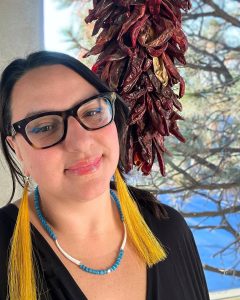 Feather Miigwans is an artist and curator from the Little Traverse Bay Bands of Odawa Indians whose transdisciplinary practice bridges technology, fashion, storytelling, and exhibition-making to center Indigenous knowledge systems and futurisms. She creates immersive experiences using augmented reality, virtual reality, and 360° media to activate ancestral memory and explore survivance through digital ceremony.
Feather Miigwans is an artist and curator from the Little Traverse Bay Bands of Odawa Indians whose transdisciplinary practice bridges technology, fashion, storytelling, and exhibition-making to center Indigenous knowledge systems and futurisms. She creates immersive experiences using augmented reality, virtual reality, and 360° media to activate ancestral memory and explore survivance through digital ceremony.
As a curator and writer specializing in contemporary Indigenous art, she is committed to creating spaces that honor Native voices, hold space for grief and resilience, and confront the layered impacts of colonial violence. Her curatorial work is deeply rooted in Anishinaabe values of kinship, responsibility, and cultural continuity—seeking to amplify community narratives of strength, care, and creative persistence.
She is also active in Indigenous fashion, blending cultural aesthetics with modern design to assert identity and visibility. Across all forms, her work invites audiences to engage with Indigenous worlds—past, present, and future—through immersive and embodied storytelling.
Curatorial Mentor
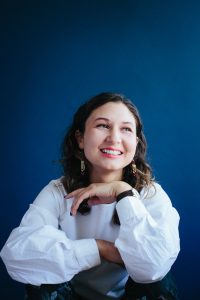 Cass Gardiner is an Anishinaabe Algonquin filmmaker, curator, and writer from Kebaowek First Nation in what we now call Quebec, Canada. She directed the short film JANELLE NILES: INCONVENIENT, part of Citizen Minutes Season 2 JANELLE NILES: INCONVENIENT premiered at Hot Docs Canadian International Documentary Film Festival in 2023 and is streaming on CBC Gem and Crave. She produced the short documentary JEWELS HUNT, which was supported by ITVS and TFI, and broadcast on PBS Independent Lens in 2020.
Cass Gardiner is an Anishinaabe Algonquin filmmaker, curator, and writer from Kebaowek First Nation in what we now call Quebec, Canada. She directed the short film JANELLE NILES: INCONVENIENT, part of Citizen Minutes Season 2 JANELLE NILES: INCONVENIENT premiered at Hot Docs Canadian International Documentary Film Festival in 2023 and is streaming on CBC Gem and Crave. She produced the short documentary JEWELS HUNT, which was supported by ITVS and TFI, and broadcast on PBS Independent Lens in 2020.
She was a 2017 Curatorial Fellow at the Center for Craft in Asheville, North Carolina, where she curated Crafted Strangers, exploring shared cultural struggles between Indigenous and immigrant communities through craft. In 2018, she co-curated Forward Facing with Critical Distance and the Indigenous Curatorial Collective, which was a featured show of the Scotiabank CONTACT Photography Festival. Her writing on Indigenous art, film, and food has appeared in Inuit Art Quarterly, Cherry Bombe, and Compound Butter, and has been accepted to the Oxford Food Symposium in 2023 and 2024.
Cass has held a variety of positions within documentary film institutions, namely the National FilmBoard of Canada, Hot Docs Canadian International Documentary Film Festival, and most recently the Tribeca Film Institute. She is an independent film curator for the Smithsonian National Museum of the American Indian in New York City, curating the annual Native Cinema Showcase in Santa Fe, New Mexico from 2020 to present. She holds a BA from NYU Gallatin and an MFA in Documentary Film from Toronto Metropolitan University.
The curatorial essays presented as part of Echo Lines are supported by the Indigenous Curatorial Collective / Collectif des commissaires autochtones (ICCA) through its Curatorial Mentorship Program. This program fosters mentorship between emerging and established Indigenous curators, encouraging collaborative exhibition-making, research, and critical writing rooted in Indigenous knowledge systems and collective practice. Through Echo Lines, participants co-developed new exhibitions and essays that reflect intergenerational dialogue, cultural continuity, and the diverse curatorial voices shaping the future of Indigenous contemporary art.


